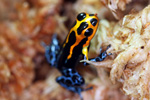
Sirenoscincus mobydick. Image courtesy of France’s National Centre for Scientific Research.
An international team of scientists have described a bizarre new species of worm-like lizard that lives underground. Strangely, they named it the “Moby Dick” mermaid skink.
The researchers chose Sirenoscincus mobydick for the lizard’s unusual appearance, which includes a complete absence of pigmentation, a lack of rear legs, flipper-like front legs, and nearly non-existent eyes, characteristics that the scientists liken to the fictional albino sperm whale conceived by author Herman Melville in his literary classic Moby Dick. The scientists say the species has anatomical traits found in amphibians, reptiles, mammals and birds.
Sirenoscincus mobydick was described last year in the journal Zoosystema.
Isolated for 88 million years, the island of Madagascar has high levels of endemism. About ninety-five percent of its reptiles are found no where else on Earth.
CITATION: Aurélien Miralles et al (2012). Variations on a bauplan: description of a new Malagasy “mermaid skink” with flipper-like forelimbs only (Scincidae, Sirenoscincus Sakata & Hikida, 2003). Zoosystema 34(4):701-719.
Related articles
‘Penis snake’ discovered in Brazil is actually a rare species of amphibian
(08/02/2012) A creature discovered by engineers building a dam in the Amazon is a type of caecilian, a limbless amphibian that resembles an earthworm or as some are noting, part of the male anatomy.
The dark side of new species discovery

(12/21/2011) Scientists and the public usually rejoice when a new species is discovered. But biologist Bryan Stuart has learned the hard way that the discovery of new species, especially when that species is commercially valuable, has a dark side-one that could potentially wipe out the new species before protections can be put in place. Stuart has discovered 27 species unknown previously to scientists – so far. That includes 22 species of frogs, three types of snakes, and two salamanders. His experience with one of these, a warty salamander from Laos with striking markings (Laotriton laoensis), opened his eyes to a dark side of scientific discovery: commercial overexploitation before protections are in place. Shortly after Stuart described the previously unknown species Paramesotriton laoensis in a scientific paper published in 2002, commercial dealers began collecting this Lao newt for sale into the pet trade. In essence, the dealers used Stuart’s geographic description in the paper as a “roadmap” to find the rare newt.